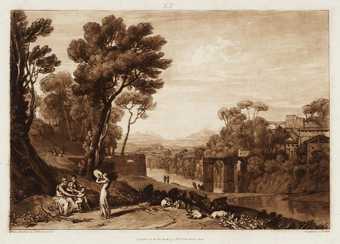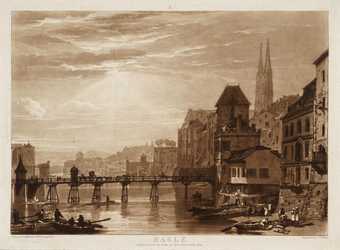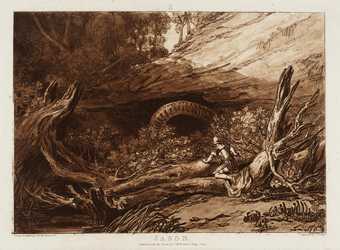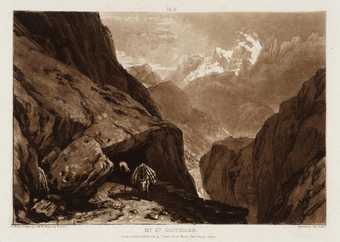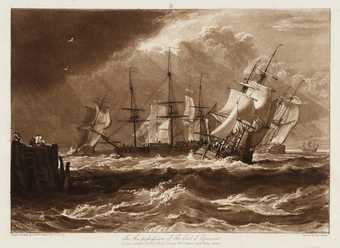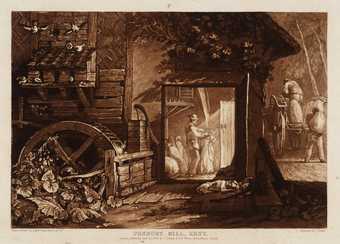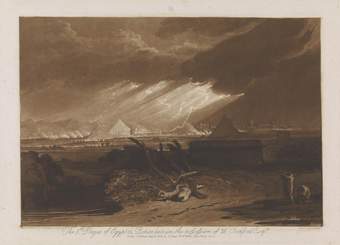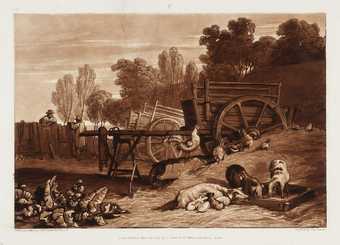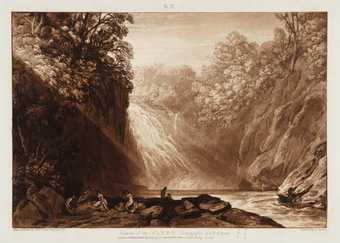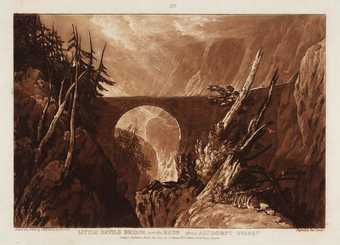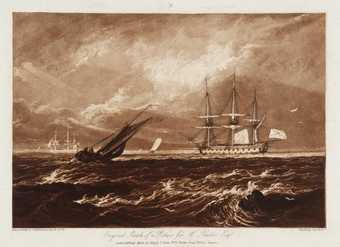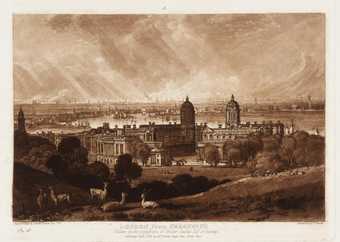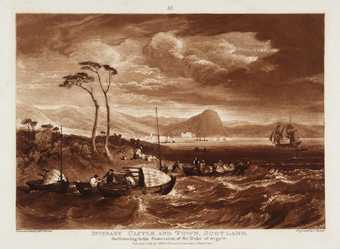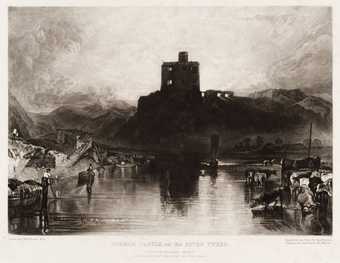
Not on display
- Artists
-
After John Doyle 1797–1868
Charles Mottram 1807–1876 - Medium
- Engraving and mezzotint on paper
- Dimensions
- Image: 580 × 866 mm
- Collection
- Tate
- Acquisition
- Presented by Dr David Blayney Brown 1987
- Reference
- T04907
Display caption
The poet, banker and collector Samuel Rogers hosted legendary breakfasts at his London home for writers, artists and other friends. As was custom at the time, they were all-male gatherings. Here, the elderly Rogers is seated in the middle. Byron is on his right. Turner, second from right, examines a picture. Other guests include Walter Scott, Thomas Campbell and Thomas Moore. This scene is an imaginary one. Turner attended Rogers’s breakfasts, but he probably never met Byron. The writer John Ruskin believed Rogers introduced Turner to ‘modern thought’ expressed in writing.
Gallery label, November 2022
Does this text contain inaccurate information or language that you feel we should improve or change? We would like to hear from you.
Catalogue entry
T04907 Portrait of J.M.W. Turner (‘The Fallacy of Hope’) engr. Charles Joseph Hullmandel, pub.1851
Engraving and mezzotint 580x866 (23 x 24) on wove paper 658 x902 (26 x 35 ½ ); plate mark 642 x 876 (25 ¼ x 34 ½ )
Engraved inscriptions: ‘Pedestal carved by Sir Francis Chantrey R.A.’ below image b.l., ‘Anno 1815’ below image near centre, ‘Charles Mottram’ below image b.r., and , from l. to r. facsimile signatures of the breakfast guests, ‘John Flaxman Walter Scott James Mackintosh Lansdowne R.B. Sheridan Thomas Moore Sydney Smith Wm
Wordsworth Robt. Southey S.T. Coleridge Washington Irving Sam1 Rogers Byron J.P. Kemble F Jeffrey Thos Stothard Thos Lawrence J.M.W. Turner T. Campbell’
Presented by Dr David Blyney Brown 1987
Prov: ...; Louis Meier; ...; Alec Stirling, by whom given to Dr David Blayney Brown
Lit: D.B. Brown, ‘New Light on “H.B.”; an Early Work by John Doyle’, Print Quarterly, vol.2, no.1, March 1985, pp.48-9
Samuel Rogers (1763–1855), banker, connoisseur and poet, was a popular and ubiquitous figure in the society of Regency London. As remarkable for his cadaverous appearance - which earned from the painter A.W. Callcott the nickname ‘Mr. Von Dug Up’ - as for his witty conversation, he was the friend of politicians, artists and men of letters (see P.W. Clayden, Rogers and his Contemporaries, 1889; R. Ellis Roberts, Samuel Rogers and his Circle, 1910; A. Dyce, Recollections of the Table-Talk of Samuel Rogers, ed. Morchard Bishop, 1952). He was the first to employ J.M.W. Turner to illustrate his own works, his Italy and Poems, not notably successful when first published, becoming best-sellers when issued with Turner's vignettes in 1830 and 1834. He was a particular friend of Thomas Stothard and Thomas Lawrence, collected antiquities, vases, coins and medals besides pictures, and was a Trustee and benefactor of the National Gallery and a founder member of the Arundel Society for the promotion of interest in early Italian art. His town house at 22 St James's Place was arranged with exquisite taste, and it was here that he held the famous breakfast parties at which he entertained men from many walks of life.
T04907 purports to show one such occasion, and the underline of the print assigns it to 1815. The host is seated in the foreground, his face turned in profile. His guests are, from left to right: John Flaxman, sculptor; Walter Scott, poet and novelist; Sir James Mackintosh, philosopher; Henry Petty-Fitzmaurice, 3rd Marquis of Lansdowne, Whig statesman; R.B. Sheridan, playwright; Thomas Moore, poet; Sydney Smith, clergyman and wit; the Lake poets Wordsworth, Southey and Coleridge; Washington Irving, American author; Byron, poet; J.P. Kemble, actor; Francis Jeffrey, editor and critic; the artists Stothard, Lawrence and Turner; and Thomas Campbell, poet. This remarkable gathering is assembled in Rogers's dining room, the focal point of his house, which also contained his writing table and some of his most important works of art. Certain of its contents are accurately portrayed and may be identified from the description of the house printed in the Athenaeum, 29 December 1855, and reprinted in G. Redford, Art Sales, 1, 1888, pp.150–2. The view is taken from in front of the window, which may be seen reflected in the glass over the sideboard behind the table; at left is the ‘handsome mahogany pedestal, surmounted by a beautiful vase; the latter is antique, the former the work of Chantrey when a journeyman’. On the sideboard stands one of a pair of ‘ancient painted Greek vases’ and Louis-François Roubiliac's terracotta bust of Alexander Pope, now in the Barber Institute, University of Birmingham. Over the glass is the fresco fragment of two haloed mourners from the Manetti Chapel in Sta Maria del Carmine, Florence, which Rogers attributed to Giotto but which is now known to be by Spinello Aretino (National Gallery). The two small pictures at either side are unidentified, but in the corner to the left stands Michelangelo's terracotta modello for his statue of Lorenzo de' Medici (National Gallery of Scotland). The pictures on the left-hand wall cannot be recognised for certain since by the time the Athenaeum and observers like Anna Jameson described them, it had been rehung to accommodate Velasquez's study of the ‘Infant Don Balthazar Carlos in the Riding School’ (Wallace Collection), seen by David Wilkie in Madrid in 1828 and bought by Rogers on his advice. Nor is it possible to distinguish the picture being examined on the opposite wall by Turner and Lawrence. It has evidently been swung forward in the manner described in the Athenaeum: ‘Many of the largest pictures in this room are contrived by very simple machinery to advance from the wall, and turn in almost every possible direction’.
Although Mottram's name is the only one cited in the underline to this print, another proof impression in a different shade of brown ink, long kept with the Tate Gallery's example, is inscribed in pencil in a contemporary hand, ‘Painted by John Doyle’. Charles Mottram (1807–76) was exclusively a reproductive engraver, chiefly known for his translations of Edwin Landseer and John Martin, and as this print must have been made when he was very young indeed, it is all the more likely that he depended on a design by another hand. His prints are listed in the catalogues of the Printsellers Association only from 1847, but this subject is too early to feature there. It must date from considerably later than 1815, the date given in the underline, since the engraver was then aged only eight, but presumably from before 1824, the year of Byron's death, since the poet is included among the breakfast guests. A date in the early 1820s would fit with the facts of Doyle's early career, and there is no reason to doubt that the original drawing was his.
Doyle had studied first in his native Dublin under the miniature painter John Comerford, following his master as a portraitist and miniaturist. In 1821 he moved to London and presumably continued to practise in these fields, both independently and for engravers and printsellers, for six or seven years. It was only in 1827 that he turned to producing the original caricature lithographs, Political Sketches, for which he is now chiefly remembered. These were issued under the intentionally tantalising initials ‘H.B.’, a monogram formed of two J.D.s over each other. Anonymity was always a fundamental concern for Doyle, and his wishes must account for the absence of any acknowledgement to him on Mottram's print; as the Dictionary of National Biography observed, it was to prevent disclosure of H.B.'s identity that Doyle did not publish his authorship of another large group subject, ‘The Reform Bill Receiving the King's Assent by Royal Commission’, engraved by Walker and Reynolds in 1836.
Published in:
Tate Gallery: Illustrated Catalogue of Acquisitions 1986-88, London 1996
Explore
- interiors(2,776)
-
- domestic(1,795)
-
- dining room(64)
- eating and drinking(409)
-
- breakfast(24)
- chair(915)
- table(754)
- table cloth(51)
- cup / mug(154)
- jug(228)
- actions: expressive(2,622)
-
- talking(602)
- sitting(3,347)
- man(10,453)
- group(4,227)
- Byron, George Gordon Byron, 6th Baron(8)
- Coleridge, Samuel Taylor(7)
- Flaxman, John(3)
- Jeffrey, Francis(2)
- Kemble, John Philip(3)
- Landsdowne, Henry Petty-Fitzmaurice, 3rd Marquis of(1)
- Lawrence, Thomas(4)
- Mackintosh, James(1)
- Rogers, Samuel(2)
- Scott, Walter, Sir(34)
- Sheridan, Richard Brinsley(3)
- Smith, Sydney(2)
- Southey, Robert(2)
- Stothard, Thomas(1)
- Turner, Joseph Mallord William(21)
- Wordsworth, William(3)
- groups(310)
- arts and entertainment(7,210)
-
- actor(261)
- artist, painter(2,545)
- artist, sculptor(1,668)
- collector / patron(1,017)
- philosopher(51)
- author(2,118)
- critic(454)
- playwright(684)
- poet(655)
- clergyman(139)
You might like
-
Joseph Mallord William Turner Woman and Tambourine, engraved by Charles Turner
1807 -
Joseph Mallord William Turner Basle, engraved by Charles Turner
1807 -
Joseph Mallord William Turner Jason, engraved by Charles Turner
1807 -
Joseph Mallord William Turner Mt St Gothard, engraved by Charles Turner
1808 -
Joseph Mallord William Turner Ships in a Breeze, engraved by Charles Turner
1808 -
Joseph Mallord William Turner Pembury Mill, Kent, engraved by Charles Turner
1808 -
Joseph Mallord William Turner The Fifth Plague of Egypt, engraved by Charles Turner
1808 -
Joseph Mallord William Turner The Farm-yard with the Cock, engraved by Charles Turner
1809 -
Joseph Mallord William Turner Drawing of the Clyde, engraved by Charles Turner
1809 -
Joseph Mallord William Turner Little Devil’s Bridge, engraved by Charles Turner
1809 -
Joseph Mallord William Turner The Leader Sea Piece, engraved by Charles Turner
1809 -
Joseph Mallord William Turner Morpeth, engraved by Charles Turner
1809 -
Joseph Mallord William Turner London from Greenwich, engraved by Charles Turner
1811 -
Joseph Mallord William Turner Inverary Castle and Town, Scotland, engraved by Charles Turner
1816 -
After Joseph Mallord William Turner Norham Castle, on the River Tweed, engraved by Charles Turner
1824

